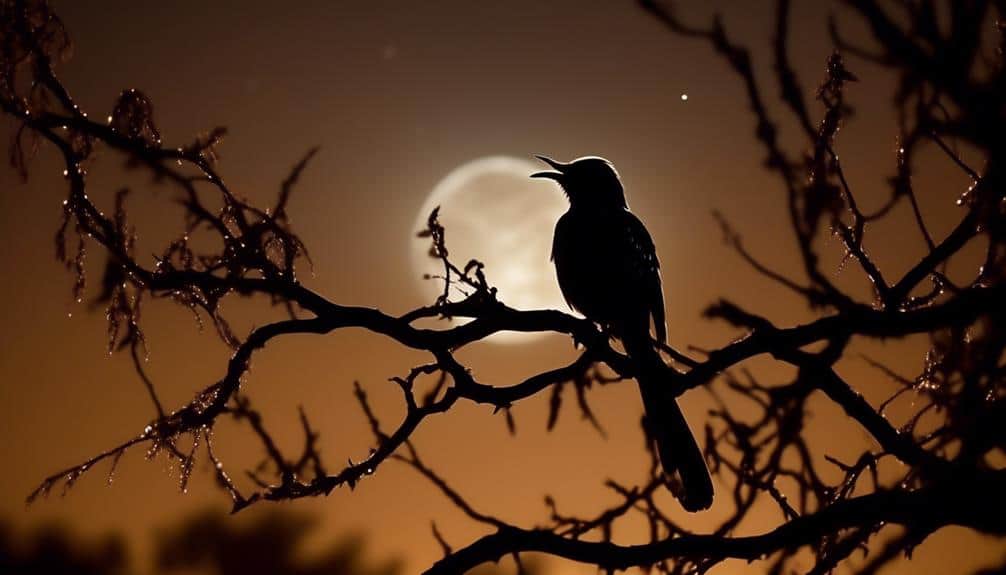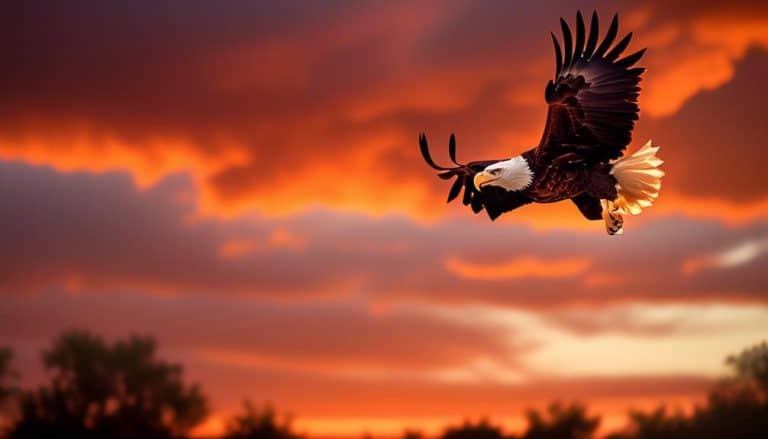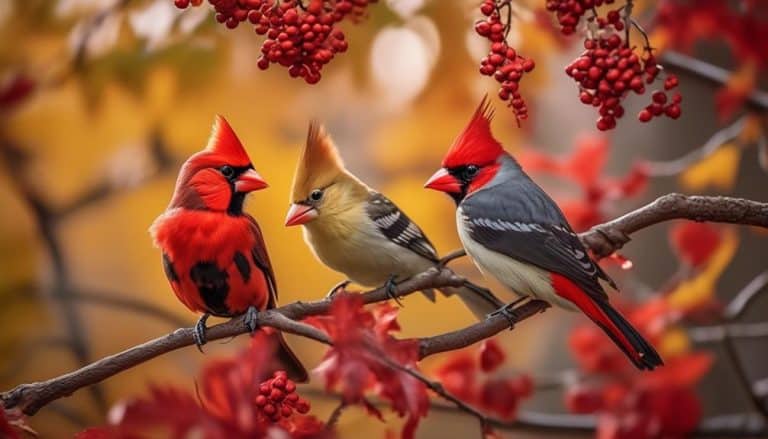As a nature enthusiast, I find myself fascinated by the feathered creatures that fill the night air with their melodic tunes in the Lone Star State. From the haunting hoots of the Eastern Screech-Owl to the mesmerizing trills of the Common Poorwill, the nocturnal symphony never fails to captivate.
However, there is one bird in particular that has piqued my curiosity, with its mysterious call echoing through the darkness. A secretive performer who goes by the name Chuck-will's-widow. Who is this enigmatic avian crooner, and what secrets does it hold in its melodious repertoire?
Join me on this journey as we uncover the nocturnal singers of the Texas skies.
Eastern Screech-Owl: The Haunting Night Caller
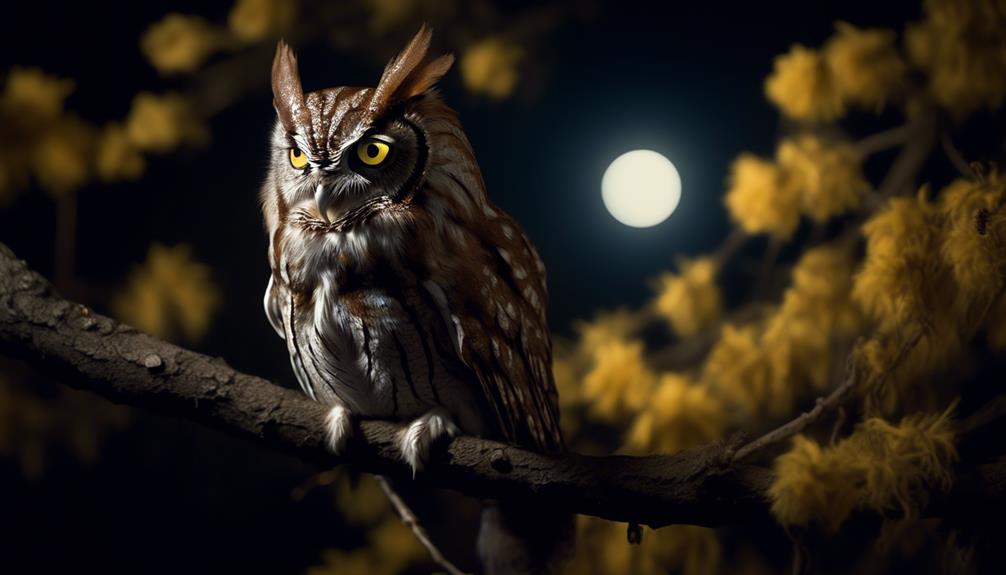
The Eastern Screech-Owl, a small nocturnal bird found in Texas, is known for its haunting call that pierces through the night. As a nocturnal predator, the Eastern Screech-Owl relies on its unique vocalizations to communicate and establish territories. These vocalizations serve various functions, including courtship, territorial defense, and communication between mates.
The Eastern Screech-Owl produces a wide range of vocalizations, but its most distinctive call is the eerie trill that resonates in the darkness. This call is often described as a series of descending whistles, ending with a tremolo-like sound that's both haunting and captivating. The purpose of this call is to attract a mate and establish its territory. By projecting its call into the night, the Eastern Screech-Owl asserts its presence and warns other owls to stay away.
Interestingly, the Eastern Screech-Owl has the ability to change the pitch and tone of its vocalizations, allowing for individual variation within the species. This adaptability in vocalizations may play a role in mate selection and recognition, as well as in distinguishing different individuals within a population.
Common Poorwill: Melodic Trills in the Darkness

Under the cover of darkness in the vast expanse of Texas, the Common Poorwill serenades the night with its melodic trills. As one of the nocturnal singers, this small, insect-eating bird fills the night air with its unique calls. The Common Poorwill, scientifically known as Phalaenoptilus nuttallii, is a member of the nightjar family, Caprimulgidae.
These nighttime melodies can be heard throughout the western and southwestern regions of Texas, particularly during the breeding season. The male Common Poorwill perches on the ground or low branches, using its vocalizations to communicate with potential mates and establish its territory. Its trills are characterized by a series of high-pitched, descending notes, creating a soothing and melodic sound that carries through the night.
The Common Poorwill's trills serve multiple purposes. They not only attract females but also deter rival males from encroaching on their territory. These vocalizations are essential for the survival and reproductive success of this species, as they allow individuals to communicate in the dark and establish their presence within the dense vegetation that they inhabit.
As a nocturnal singer, the Common Poorwill adds to the rich tapestry of sounds that fill the Texas night. Its melodic trills provide a captivating auditory experience, reminding us of the hidden wonders that exist under the cover of darkness.
Chuck-will's-widow: The Nighttime Serenader

Chuck-will's-widow, scientifically known as Antrostomus carolinensis, is a nocturnal bird species found in Texas that serenades the night with its captivating melodies. As a member of the nightjar family, this bird exhibits fascinating nocturnal habits and has specific habitat preferences.
Chuck-will's-widow is primarily active during the night, using its remarkable vocal abilities to communicate and establish territory. Its distinctive call, resembling the phrase 'chuck-will's-widow,' can be heard echoing through the darkness. This species possesses a unique vocal apparatus, which allows it to produce a deep, resonant call that carries over long distances. By singing at night, Chuck-will's-widow avoids competition with diurnal species and maximizes its chances of attracting potential mates.
When it comes to habitat preferences, Chuck-will's-widow favors wooded areas with open understory, such as pine forests, oak woodlands, and scrublands. These habitats provide the bird with ample camouflage and nesting opportunities. Chuck-will's-widow typically builds its nest on the ground, blending seamlessly with the surrounding leaf litter. This choice of nesting location also aids in protecting its eggs and chicks from potential predators.
In Texas, Chuck-will's-widow can be found across the eastern, central, and southern parts of the state. It's often encountered in areas with a mix of forested and open landscapes, where it can find an abundance of insects to feed on during the night.
Mexican Whip-poor-will: A Texas Twilight Songster
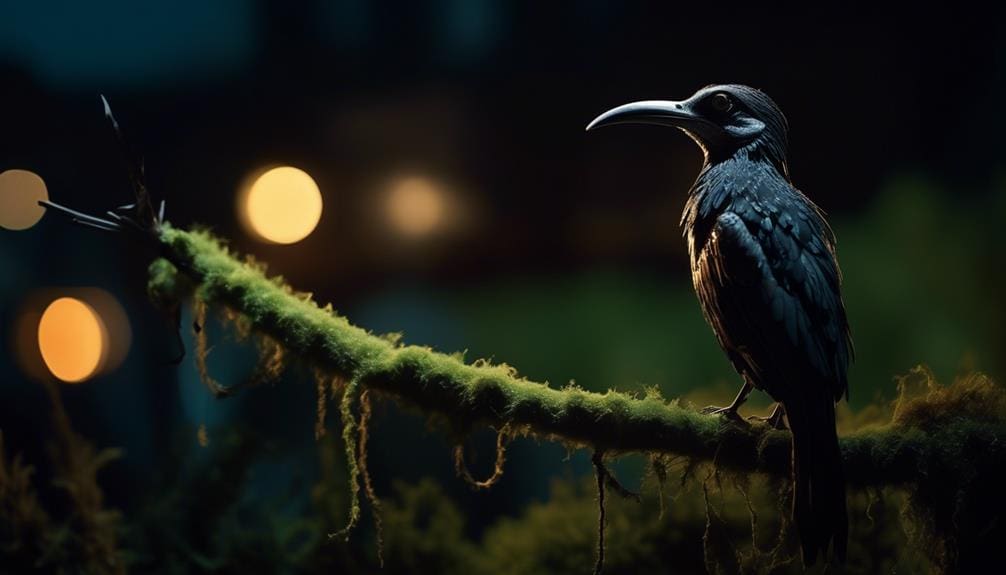
The Mexican Whip-poor-will, also known as Caprimulgus arizonae, is an avian species found in Texas that displays its melodious twilight song. This unique bird has fascinating habitat and migration patterns, as well as distinct vocalizations and mating behaviors.
Here are some interesting facts about the Mexican Whip-poor-will:
- Habitat and Migration Patterns:
- The Mexican Whip-poor-will prefers habitats with dense vegetation, such as woodlands, forests, and brushy areas.
- During migration, these birds can be found in various regions of Texas, including the Edwards Plateau and the Rio Grande Valley.
- Unique Vocalizations:
- The Mexican Whip-poor-will is known for its distinctive call, which resembles its name. It produces a repetitive 'whip-poor-will' sound during the twilight hours.
- These vocalizations are primarily performed by the males, who use them to establish territory and attract females.
- Mating Behaviors:
- During the breeding season, male Mexican Whip-poor-wills engage in elaborate courtship displays. They perform acrobatic flights and vocalize to attract females.
- Once a pair forms, the female lays one or two eggs on the ground, usually in a well-hidden location. Both parents take turns incubating the eggs and raising the nestlings.
The Mexican Whip-poor-will is an enchanting species that adds to the diversity of Texas' nighttime serenaders. Understanding its habitat, migration patterns, unique vocalizations, and mating behaviors allows us to appreciate the wonders of nature that surround us.
Great Horned Owl: The Powerful Voice of the Night
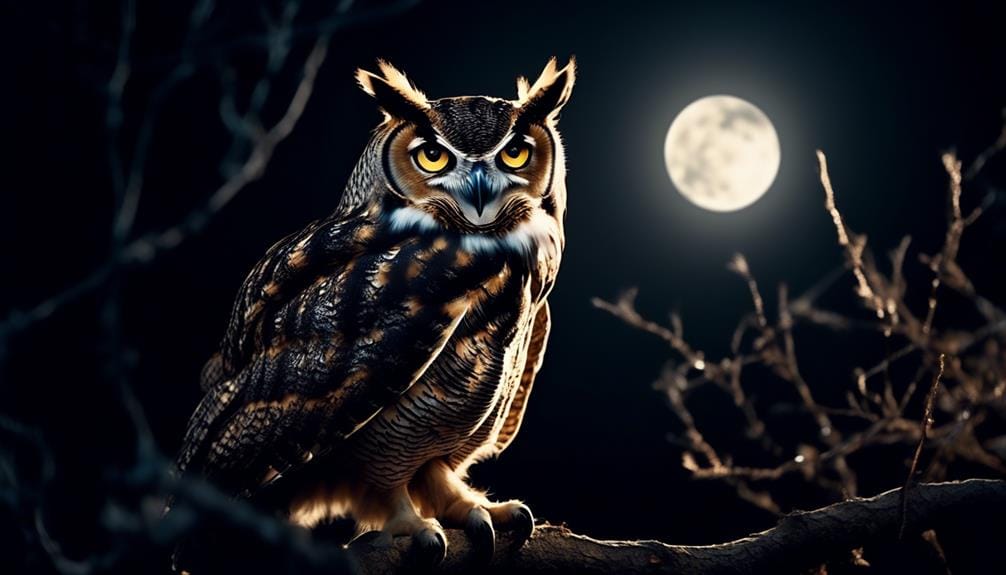
As we shift our focus to the powerful voice of the night, we encounter the Great Horned Owl, an impressive avian species found in Texas that commands attention with its commanding vocalizations and nocturnal prowess.
The Great Horned Owl, also known as Bubo virginianus, is a prominent owl species in Texas and is revered for its unique vocalizations. With its deep, resonant hoots that carry through the darkness, the Great Horned Owl establishes its presence in the night. These vocalizations serve multiple purposes, including territorial defense, attracting mates, and communicating with their young.
The Great Horned Owl's vocal repertoire is diverse and consists of various hoots, growls, screams, and hisses. Their calls are characterized by a rhythmic pattern, with a distinctive 'hoo-hoo-hoo' sound followed by a lower-pitched 'hoo-hoo-ooo'. This vocalization is often described as sounding like 'who's awake? me too', and can be heard throughout the night, especially during breeding season.
The powerful voice of the Great Horned Owl can carry for miles, allowing them to communicate and establish their presence over large territories.
In addition to their vocalizations, the Great Horned Owl possesses impressive nocturnal abilities. Their large eyes are adapted for low-light conditions, and their keen hearing enables them to locate prey in the dark. With their powerful talons and strong beaks, they're skilled hunters, feeding on a wide range of prey including small mammals, birds, and even reptiles.
Frequently Asked Questions
What Are the Physical Characteristics of the Eastern Screech-Owl?
The eastern screech-owl has distinct physical characteristics, including a small size, feathered tufts on its head, and mottled gray or red-brown plumage. Its behavior and habits involve roosting in tree cavities and emitting eerie, high-pitched trills at night.
What Is the Diet of the Common Poorwill?
The Common Poorwill, a nocturnal bird, has a unique diet consisting primarily of insects. Its feeding habits are fascinating as it hunts for prey under the cover of darkness, using its specialized adaptations to locate and capture its food.
How Does the Chuck-Will's-Widow Attract a Mate During the Night?
During the night, the chuck-will's-widow attracts a mate through its vocalization patterns. These patterns include a series of soft, low-pitched calls that are repeated at regular intervals, creating a distinct and alluring song.
What Habitat Does the Mexican Whip-Poor-Will Prefer in Texas?
The Mexican whip-poor-will prefers habitats with open woodlands, scrublands, and grasslands in Texas. I will provide detailed information on their preferred habitats and their migratory patterns.
How Far Can the Call of the Great Horned Owl Be Heard During the Night?
The call of the great horned owl can have various effects on other nocturnal birds. Different calls of the owl, such as hoots, screams, and barks, serve different purposes and convey different meanings to communicate with other birds.
Conclusion
In conclusion, the nocturnal avian species found in Texas possess an intricate repertoire of melodic calls that resonate through the night. From the haunting trills of the Eastern Screech-Owl to the captivating serenades of the Chuck-will's-widow, these birds showcase their powerful voices in the darkness.
The Mexican Whip-poor-will adds a touch of twilight melody, while the Great Horned Owl reigns as the commanding voice of the night. These feathered creatures truly paint the Texas nights with their enchanting songs, like a symphony under the stars.

